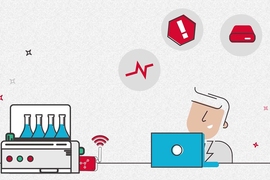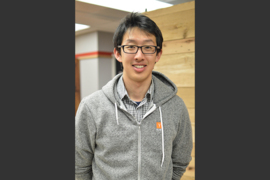Although Internet-connected “smart” devices have in recent years penetrated numerous industries and private homes, the technological phenomenon has left the research lab largely untouched. Spreadsheets, individual software programs, and even pens and paper remain standard tools for recording and sharing data in academic and industry labs.
TetraScience, co-founded by Spin Wang SM ’15, a graduate of electrical engineering and computer science, has developed a data-integration platform that connects disparate types of lab equipment and software systems, in-house and at outsourced drug developers and manufacturers. It then unites the data from all these sources in the cloud for speedier and more accurate research, cost savings, and other benefits.
“Software and hardware systems [in labs] cannot communicate with each other in a consistent way,” says Wang, TetraScience’s chief technology officer, who co-founded the startup with former Harvard University postdocs Salvatore Savo and Alok Tayi. “Data flows through systems in a very fragmented manner and there are a lot of siloed data sets [created] in the life sciences. Humans must manually copy and paste information or write it down on paper, [which] is a lengthy manual process that’s error prone.”
TetraScience has developed an Internet of Things (IoT) hub that plugs into most lab equipment, including freezers, ovens, incubators, scales, pH meters, syringe pumps, and autoclaves. The hub can also continuously collect relevant data — such as humidity, temperature, gas concentration and oxygen levels, vibration, light intensity, and mass air flow — and shoot it to TetraScience’s centralized data-integration platform in the cloud. TetraScience also has custom integration methods for more complicated instruments and software.
In the cloud dashboard, researchers can monitor equipment in real time and set alerts if any equipment deviates from ideal conditions. Data appears as charts, graphs, percentages, and numbers — somewhat resembling the easily readable Google Analytics dashboard. Equipment can be tracked for usage and efficiency over time to determine if, say, a freezer is slowly warming and compromising samples. Researchers can also comb through scores of archived data, all located in one place.
“Our technology is establishing a ‘data highway’ system between different entities, software and hardware, within life sciences labs. We make facilitating data seamless, faster, more accurate, and more efficient,” says Wang, who was named to this year’s Forbes 30 Under 30 list of innovators for his work with TetraScience.
More than 70 major pharmaceutical and biotech firms, including many in Cambridge, Massachusetts, use the platform. Numerous labs at MIT and Harvard are users, as well.
Pain in the lab
For Wang and his TetraScience co-founders, building their smart solution was personal.
As a Cornell University undergraduate, Wang worked in the Cornell Semiconducting RF Lab on high-energy physics research. Frustrated by the time and effort required to manually record data, he developed his own system that connected and controlled more than 10 instruments, such as a signal generator, power meter, frequency counter, and power amplifier.
Years later, as an MIT master’s student studying microelectromechanical systems, Wang worked on sensing technologies and processing of radio frequency signals under the guidance of Professor Dana Weinstein, now at Purdue University. During his final year, he wound up at the MIT Media Lab, working on a 3-D printing project with Tayi, who had spent his academic career toiling away in materials science, chemistry, and other labs. Tayi and Savo were already conducting market research around potential opportunities for IoT in labs.
All three bonded over a shared dislike for data-collecting tools that have remained relatively unchanged in labs for a half-century. “We felt the pain of manually tracking data and not having a consistent interface for all our equipment,” Wang says.
This is especially troublesome at scale. Large pharmaceutical or biotechnology firms, for instance, can have several hundreds or thousands of instruments, all with different hardware running on different software. Humans must record data and input it manually into dozens of separate recording systems, which leads to errors. People also must be physically in a lab to control experiments. Smart labs were the new frontier, Wang, Savo, and Tayi agreed.
In 2014, the three launched TetraScience to build a platform that connected equipment and pooled data into a single place in the cloud — similar to the one Wang created at Cornell, but more advanced. Back then, they used a slightly modified Raspberry Pi as their “hub,” while they refined their software and hardware.
For early-stage startup advice, the startup turned to the Industrial Liaison Program and MIT’s Venture Mentoring Service, and leveraged MIT’s vast alumni network for feedback on their technology and business plan. “We definitely benefited from MIT,” Wang says.
Saving time and money
An early trial for the platform was with the Media Lab, where researchers used the platform to monitor not equipment, but beehives. The researchers were studying how hives could be implemented into building infrastructure and how design and materials could promote bee health. As bees are sensitive to changes in environment, the researchers needed to constantly monitor temperature and humidity around hives over several months, which would be challenging if done manually.
Using TetraScience’s platform, the researchers were captured all the necessary data for their project, without suiting up and approaching all the hives daily — saving “hundreds of hours … and 686 bee stings,” according to the startup. Testing at MIT, Wang says, “helped us gain an understanding of the industry and value proposition.”
From there, the TetraScience platform found its way into more biotech companies and into more than 60 percent of the world’s top 20 pharmaceutical companies, according to the startup. Benefits of today’s TetraScience platform include speeding up research, improving compliance, producing better-quality data and, ultimately, saving millions of dollars and countless hours of work, Wang says.
Numerous case studies, listed on the startup’s webpage, showcase the platform’s efficacy and value at major pharmaceutical firms and cancer research centers, and at Harvard and MIT.
For example, in the final stages of approval of a multibillion-dollar drug, a large pharmaceutical firm conducted an accelerated lifetime test, where any prolonged deviation from preset conditions would require restarting the experiment, at the cost of millions of dollars, weeks of unusable data, and delayed commercialization. Within a few weeks of the test’s conclusion, a major deviation in one experiment occurred late at night. Within seconds, according to the study, TetraScience’s platform detected the deviation and alerted scientists, who caught it immediately, stopping any significant damage.
The platform also offers benefits for determining equipment efficiency and usage. In a 2017 case study with another pharmaceutical firm, TetraScience monitored 70 pieces of equipment. The startup flagged 23 instruments as “heavily underused.” The firm used that data to reduce service contracts for 14 instruments and sell nine instruments, leading to improved efficiency and hundreds of thousands of dollars in savings that could be put toward more research and development.
Although the startup’s focus is on pharmaceutical and biotechnology industries, the platform could also be used in oil and gas, brewing, and food and chemistry industries to see similar benefits. “Those industries all use similar instruments [as life science labs] and produce the same kind of data, such as monitoring the pH of beer, so we will get into those industries in the future,” Wang says.











